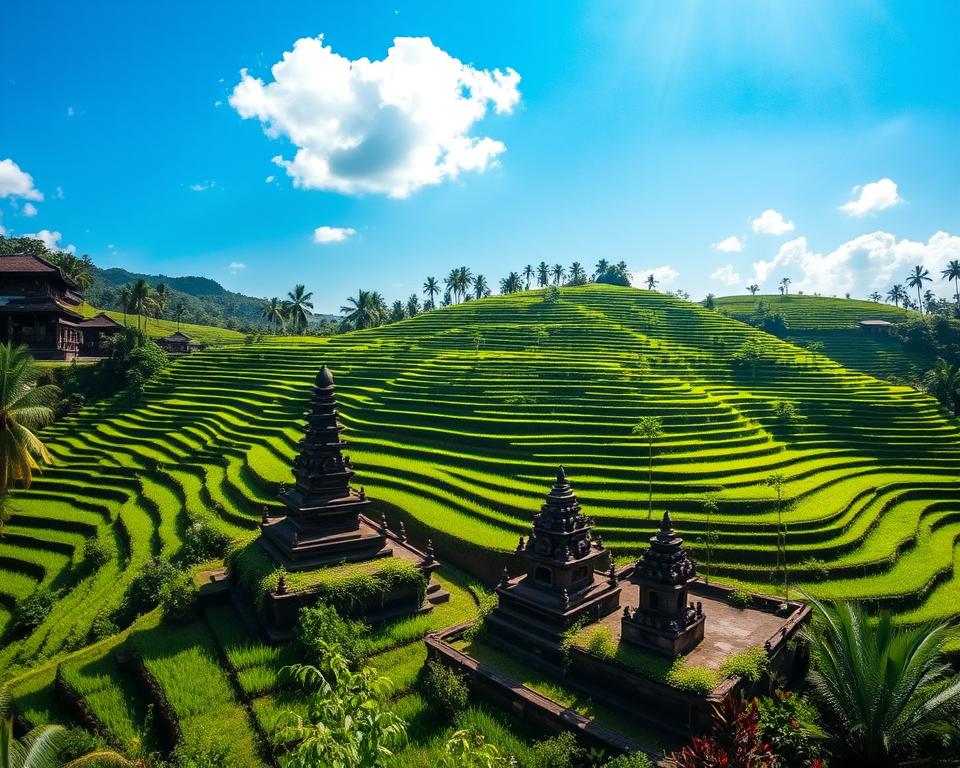
Temples Near Ubud’s Rice Terraces
Over 4.1k shares show that people love learning about temples near Ubud’s rice terraces in Bali1. The Tegalalang rice terraces and Gunung Kawi Temple are top spots to see in this beautiful area1.
Visiting the Tegalalang rice terraces is a must in Ubud. These green fields are famous for their beauty, showing off Bali’s farming history1. Tickets are very cheap, just a few cents1.
But, remember to bring an umbrella, sunscreen, and water because it’s sunny1. There are donation stands, but some people choose not to give1.
The Gunung Kawi Temple is close to the terraces. It shows Bali’s culture and spirituality2. The temple has 10 huge rock shrines, each 7 meters tall2.
Visitors can see ancient carvings, enjoy the jungle, and cool off by a stream1. But, don’t miss walking up the stairs behind the temple. You might see a big spider1!
After seeing the temples and rice terraces, people like to relax with food and drinks1.
Key Takeaways
- The Tegalalang rice terraces and Gunung Kawi Temple are must-visit attractions near Ubud in Bali.
- The Tegalalang rice terraces offer stunning scenery, but visitors should come prepared with shade, sunscreen, and water.
- Gunung Kawi Temple features intricat ancient carvings and a serene, jungle-like setting, with the full experience including walking up the stairs behind the temple.
- Visitors often enjoy cooling off with food and drinks after exploring the temples and rice terraces.
- The content related to these temples near Ubud’s rice terraces has garnered significant attention, with over 4,100 shares.
Exploring the Iconic Tegalalang Rice Terraces
The Tegalalang Rice Terraces are in Gianyar regency, surrounded by lush hills3. They are a natural wonder that attracts visitors worldwide3. The terraces are a stunning sight, with paddy fields that look like a green tapestry3.
Walking through the terraces, you’ll hear the sound of water3. It’s a peaceful place with a unique view.
Lush Green Paddy Fields and Stunning Scenery
The terraces are known for their green color and rolling hills3. They are perfect for photos, showing off the beauty of Bali4. You can walk or take a guided tour to learn about Bali’s farming history.
Guided Tours and Entrance Fees
Visiting the terraces is free, but guided tours are popular4. These tours might also visit the Tirta Empul Temple and Ubud Monkey Forest4. The cost is about IDR 15,000 to 20,000 per person4.
There might be extra fees for activities like riding swings or wearing traditional Balinese clothes4.
The Tegalalang Rice Terraces are a must-see in Bali34. They offer beautiful views, a rich history, and unique experiences.
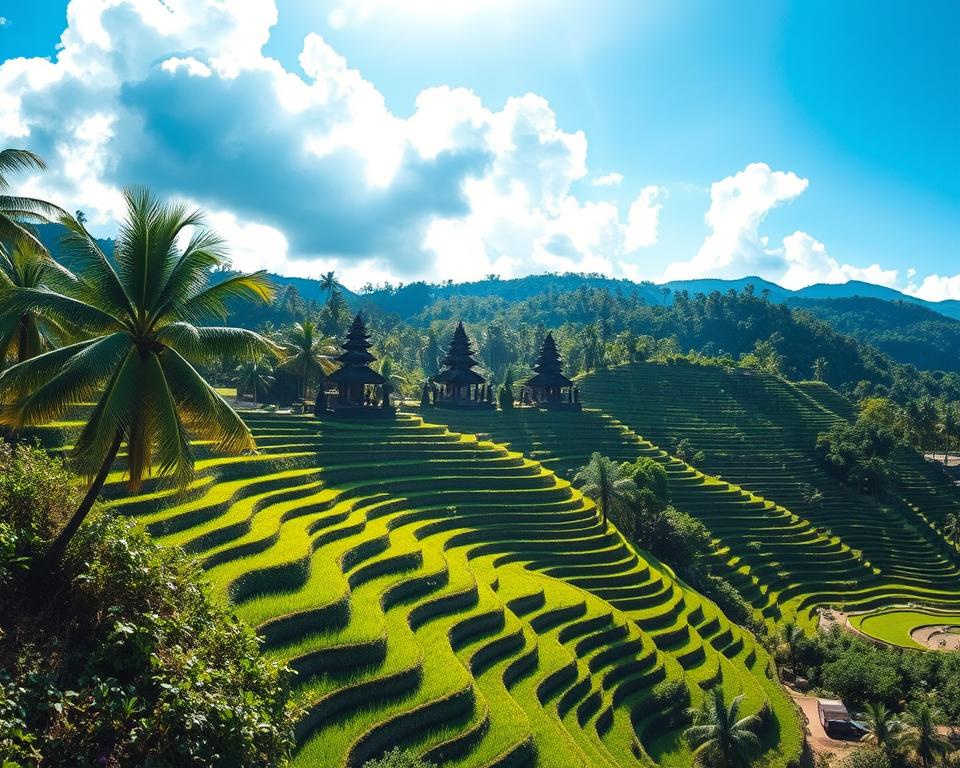
| Key Highlights | Details |
|---|---|
| Location | 3 Tegallalang Rice Terrace is located a short 20-minute drive north of Ubud4. Tegalalang Rice Terrace is located about 10 kilometers north of Ubud. |
| Exploration Time | 3 The exploration of the area around Tegallalang Rice Fields can take approximately 30 minutes to 1.5 hours. |
| Nearby Attractions | 4 Private tours may include stops at attractions such as Tirta Empul Temple and the Ubud Monkey Forest. |
| Entrance Fees | 4 Entrance fee to Tegalalang Rice Terrace is around IDR 15,000 to 20,000 per person. Parking fees for cars are usually around IDR 5,000 and for scooters approximately IDR 2,000. Additional charges may apply for activities like riding swings or taking photos in Balinese attire. |
| Best Time to Visit | 4 Best time to visit Tegalalang is during the dry season from April to October. Wet season, from November to March, offers fewer crowds and vibrant green landscapes. Early morning and late afternoon are ideal times to photograph Tegalalang Rice Terrace. |
| Activities | 4 Activities at Tegalalang include walking through the terraces, photography opportunities, and participating in rice planting or harvesting. |
| Accommodation | 4 Accommodation options in Tegalalang range from luxurious villas with private pools to cozy boutique hotels. |
“The Tegalalang Rice Terraces are a true masterpiece of nature, where the harmony between human ingenuity and the natural landscape is perfectly captured.”
Gunung Kawi: An Ancient Temple Complex
In Tampaksiring, near Ubud, is the Gunung Kawi Temple. It’s from the 11th century and shows Bali’s rich culture and faith5. The temple is carved into rock cliffs by the Pakerisan River. It has 10 shrines, with 4 on one side and 5 on the other, plus one hidden valley south5.
The shrines have big roofs with nine symbols of fertility5. Built in 1080 AD, it honors King Anak Wungsu’s father and the Warmadewa Dynasty5. Now, it feels mystical, with stories of old Balinese kings5.
When you visit, you must wear a sarong and sash, which you can rent6. The temple looks amazing during its anniversary, with decorations on the “third full moon” of the Balinese calendar5. But, women can’t go inside during their period, as they’re seen as unclean in Hindu beliefs7.
Seeing Gunung Kawi is a must for those who love Bali’s culture and faith. The carvings, the calm, and the mystery make it a memorable trip. 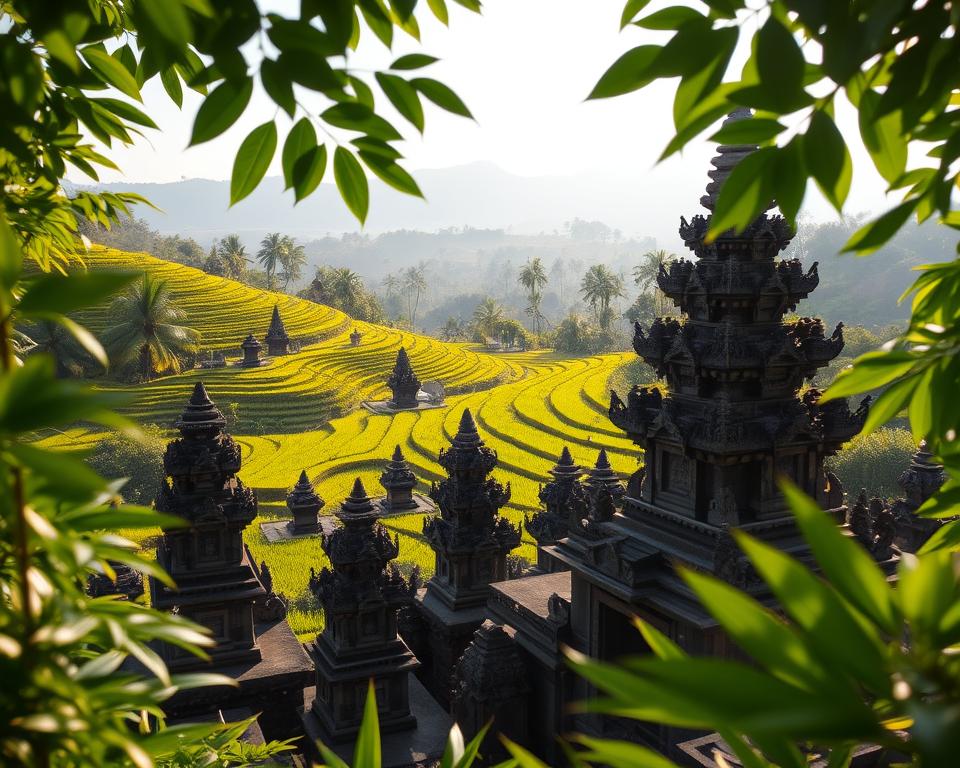
The Serene Tirta Empul Temple
The Tirta Empul Temple is in the green hills near Ubud. It shows Bali’s deep culture and spirituality. Founded in 926 A.D., it’s famous for its healing spring waters8.
This temple is one of Indonesia’s busiest water temples8. It takes about 30 minutes to an hour to see everything8.
Visitors can take part in purification rituals in the temple’s pools. These pools use water from a natural spring. It’s a way to feel the spiritual side of Balinese Hinduism8.
A legend tells of Tirta Empul’s start. It’s about a battle between Mayadenawa and Bhatara Indra8.
In 2017, the temple was visited by Barack Obama and his family. This made it famous worldwide8.
The temple’s calm and spiritual vibe attract many visitors. It’s a key place to learn about Balinese culture and traditions. A visit here is essential for those exploring Ubud and Bali’s spiritual sites8.
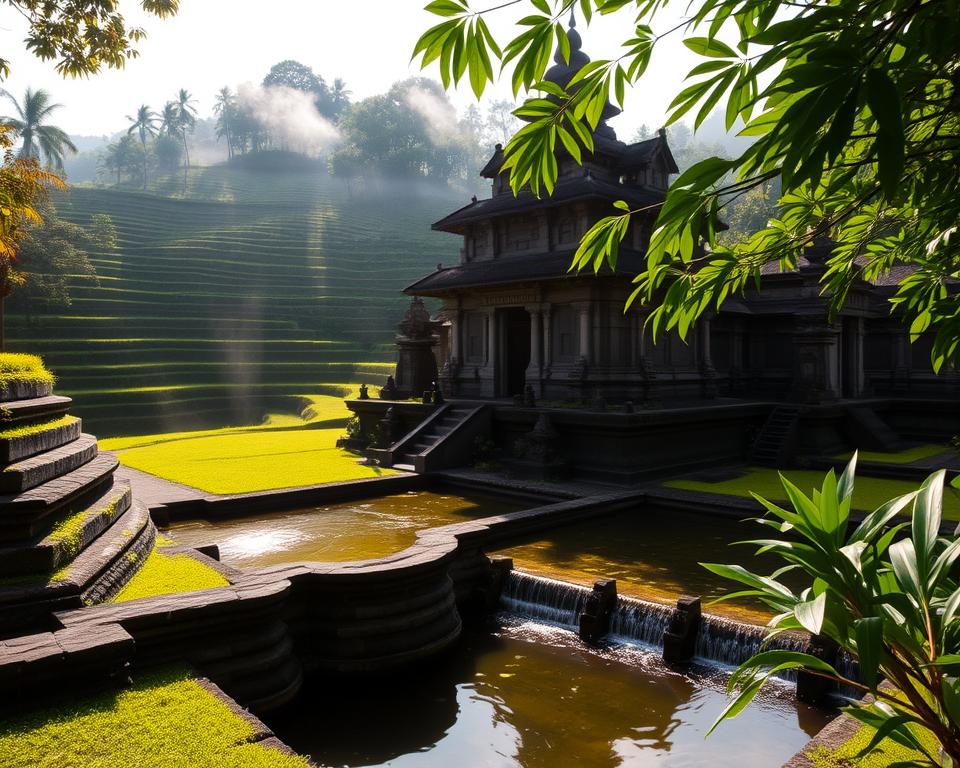
Practical Information
To get to Tirta Empul, you can rent a scooter or a car. Scooters cost between 50K to 70K rupiahs a day8. Cars cost more, from 215K to 5 million rupiahs, depending on the type and rental8.
Guided tours are also available. Prices vary based on the tour8. The temple is about 14 km from Ubud, making it easy to reach8.
Entrance fees in 2024 are IDR 50,000 for adults and IDR 25,000 for kids aged 5 to 119. You might need to rent a sarong for IDR 10,000 and a locker for IDR 15,0009. Kids under 5 get in free9.
The temple is open from 8:00 AM to 6:00 PM daily9. It’s open 24/7 for prayer and spiritual practice9. Check the latest fees and hours before you go9.
“The Tirta Empul Temple is a true gem of Balinese spirituality, giving visitors a chance to dive into the island’s rich culture and the healing power of its sacred waters.”
Goa Gajah: The Elephant Cave Temple
Nestled just 6 kilometers outside the vibrant town of Ubud in Bedulu Village, Bali, lies the captivating Goa Gajah, also known as the Elephant Cave Temple10. This ancient Hindu temple, dating back to the 11th century, is a must-visit destination for those seeking to immerse themselves in Bali’s rich cultural heritage and spiritual traditions10.
Mysterious Carvings and Cultural Significance
As you approach the temple, you’ll be immediately struck by the intricately carved entrance. It’s adorned with detailed reliefs and mysterious figures that have captured the imagination of visitors for centuries11. The temple’s unique architectural elements, blending Hindu and Buddhist influences, offer a glimpse into Bali’s ancient past and the island’s enduring spiritual beliefs11.
Wandering through the cave and surrounding temple grounds, you’ll have the opportunity to connect with the island’s ancient traditions. You’ll appreciate the cultural significance of this sacred site12. The Elephant Cave Temple has been a place of spiritual significance for centuries. Visitors can engage in thoughtful reflection and understanding of Bali’s religious heritage12.

“Goa Gajah is a true gem, showing Bali’s rich cultural tapestry and spiritual traditions. The temple’s unique carvings and serene atmosphere make it a must-visit destination for any traveler exploring the Ubud region.”
Whether you’re interested in ancient architecture, cultural heritage, or simply seeking a peaceful moment of reflection, a visit to Goa Gajah, the Elephant Cave Temple, is a captivating and enriching experience. It will leave a lasting impression101112.
Temples Near Ubud’s Rice Terraces
Bali’s culture and spirituality shine near Ubud’s rice terraces. These temples let visitors dive into the island’s history and traditions. They are surrounded by beautiful nature13.
The Gunung Kawi Temple Complex is a must-see. It has ancient rock-cut shrines and carvings from the 11th century. The Tirta Empul Temple is also close, where you can purify your spirit in its holy springs1.
The Elephant Cave Temple, or Goa Gajah, is another amazing place. It has mysterious carvings and a deep cultural meaning. Each temple near Ubud’s rice terraces lets you connect with Bali’s Hindu traditions13.
| Temple | Entrance Fee | Opening Hours |
|---|---|---|
| Goa Gajah | 15,000 IDR | Open daily |
| Tirta Empul | 50,000 IDR | Open daily |
| Pura Gunung Lebah | Donation (10,000 – 20,000 IDR) | Open daily |
Visiting these temples near Ubud’s rice terraces is special. It lets you experience the island’s natural beauty and spiritual traditions1.
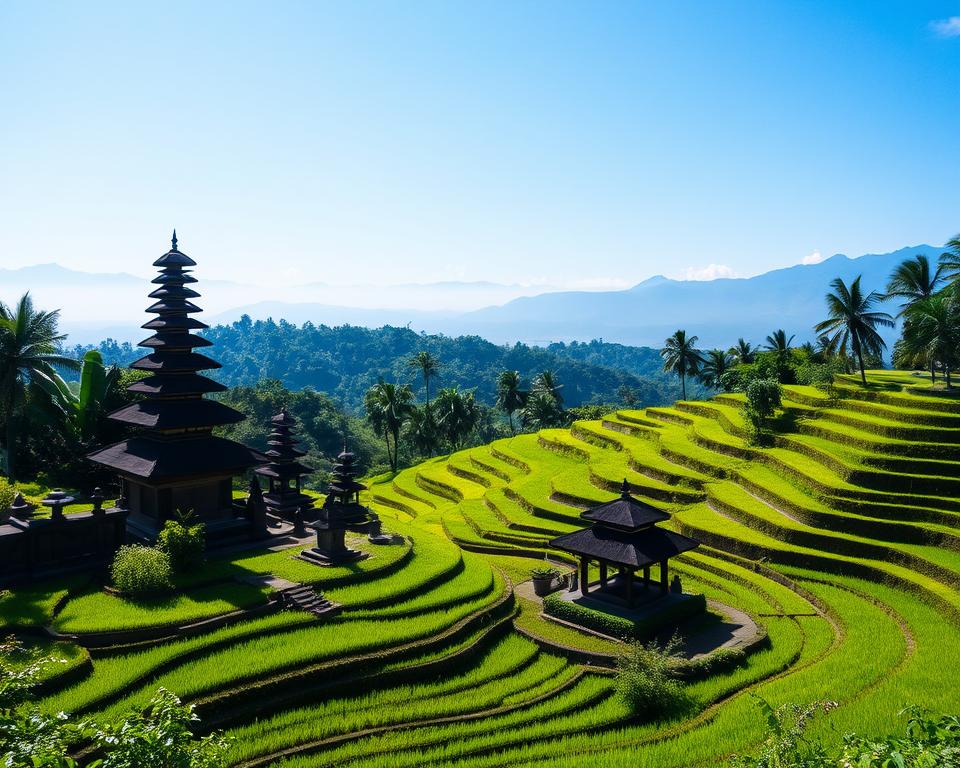
Combining Nature and Spirituality
The temples near Ubud’s rice terraces mix Bali’s stunning landscapes with its spiritual history14. They sit among green fields, rivers, and calm waters. Here, visitors find peace and can learn about Bali’s culture14.
Peaceful Ambiance and Stunning Vistas
Visiting these temples is a special experience. It shows how Bali’s nature and spirit are connected14. The Tri Hita Karana idea, about balance, is seen in these temples’ design14.
Walking through, you see beautiful rice fields, waterfalls, and mountains. These views add to the temples’ beauty14. It’s a chance to feel Bali’s spiritual side deeply14.
“The harmony between nature and spirituality is palpable in these temples, inviting visitors to immerse themselves in Bali’s rich cultural tapestry.”
These temples are great for learning about Balinese beliefs or finding quiet. They also show off Bali’s amazing natural beauty14.
Ubud’s Cultural Attractions
Ubud is more than temples and rice terraces. It’s a lively place filled with Balinese art, crafts, and cuisine15. You can see local art, visit galleries, and watch artisans at work. They make amazing wood carvings, paintings, and pottery15.
Ubud is also famous for its crafts. Here, you can find unique souvenirs and handmade items. These items show off Bali’s rich culture15. The food here is also special, with real Balinese dishes and cooking lessons15.
Balinese Art, Crafts, and Cuisine
Ubud’s art scene is amazing. You can see wood carvings, paintings, and pottery in many galleries and workshops. These show the talent of Balinese artists15. It’s a great way to see the island’s art and maybe buy something special15.
Ubud is also known for its crafts. You can find markets and workshops with lots of handmade items. There are textiles, weavings, baskets, and jewellery. These crafts show the skill of local artists and connect you to Bali’s culture15.
The food in Ubud is also a big draw. You can try Balinese cuisine like nasi campur and bebek betutu. Restaurants and cooking classes offer a chance to taste real Balinese food15. It’s a fun way to learn about the island’s food traditions15.
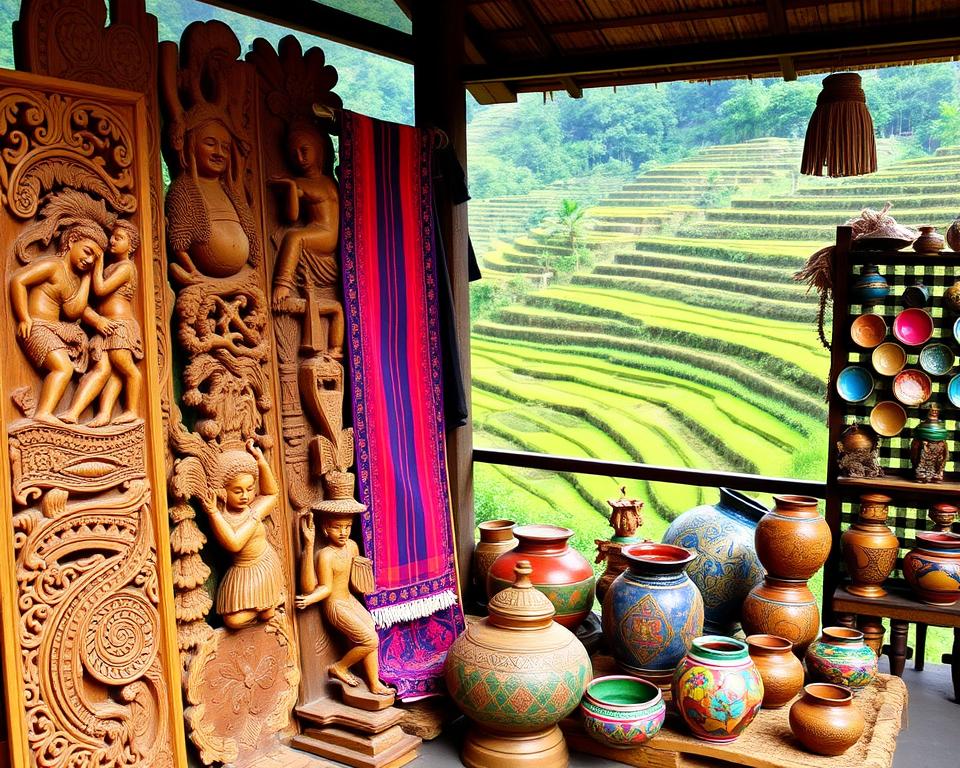
“Ubud is the cultural heart of Bali, where visitors can immerse themselves in the island’s rich artistic heritage and vibrant culinary traditions.”
Best Time to Visit Ubud’s Temples
Exploring temples near Ubud’s green rice terraces is rewarding. But when is the best time? It depends on what you like and Bali’s seasons16.
The dry season, from April to October, is great for temple visits17. The weather is warm and sunny, perfect for walking around. July is very busy because it’s the peak of the dry season18.
October, November, April, May, and June are also good. You’ll see fewer people and enjoy a calm atmosphere18.
If you want to save money, visit from December to March. It’s less crowded and hotels are cheaper, even though it’s wetter18.
Plan your temple visits well. Tegalalang Rice Terraces are best in the morning18. Pura Gunung Kawi Tampaksiring is stunning, with huge shrines carved into cliffs18.
The best time for you depends on your travel plans, budget, and what you want to see17. With some planning, your trip to Bali’s temples will be unforgettable.

Practical Tips for Temple Visits
Exploring temples near Ubud’s rice terraces? Remember the Bali cultural norms and Balinese temple etiquette. Most temples ask visitors to cover up. You can wear sarongs and clothes that cover your shoulders. You can borrow or rent these items at the temple.
It’s also key to respect these Ubud temple sites. Don’t make loud noises and take off your shoes before entering. Following these rules makes your visit more special and memorable.
Dress Code and Etiquette
- Cover up with a sarong and ensure your shoulders are covered
- Remove shoes before entering the temple grounds
- Avoid loud or disruptive behaviour within the temple precincts
- Be mindful and respectful of the sacred nature of these sites
“Adhering to the local dress code and etiquette is key for a respectful and enriching temple experience in Bali.”
By following these simple rules, you can dive into the Bali cultural norms. You’ll also understand the spiritual value of the temples near Ubud’s rice terraces19.
Ubud’s Spiritual Significance
Ubud and its temples near the rice terraces are very special to the Balinese20. These places are key to the island’s Hindu-Buddhist traditions20. They are where people go to worship, meditate, and keep their culture alive20.
When you visit these temples, you can feel Bali’s deep spiritual roots20. You learn about the island’s mix of nature and culture20. It’s a chance to really understand and appreciate Bali’s spiritual side.
Connecting with Balinese Traditions
Ubud is a top spot for spiritual seekers in Bali21. It lets visitors dive into the island’s culture and faith21. Places like Tirta Empul and Goa Gajah show the Balinese worldview20.
By joining in rituals and watching cultural shows, you connect with Bali’s life20. It’s a way to really get to know the Balinese way of life.
The temples in Ubud are more than just old buildings20. They are the heart of Balinese spirituality20. People come here to pray, meditate, and celebrate festivals20.
Visitors who are open and respectful can really feel Bali’s cultural spirit20. They see the Balinese people’s strong bond with their traditions.
“Ubud is not just a place, it’s a state of mind. Here, you can find the perfect balance between the physical and the spiritual, the material and the immaterial. It’s a sanctuary where the past and present coexist harmoniously.”
–Nyoman, local Balinese guide
Conclusion
Ubud’s temples near the rice terraces are a special treat for Australian visitors22. You can see the ancient Gunung Kawi complex and the calm Tirta Empul Temple. These places mix nature’s beauty with amazing architecture, letting you feel Bali’s traditions22.
Visiting places like the UNESCO-recognized Jatiluwih Rice Terraces2324 or the quiet Sidemen Rice Terrace22 is enriching22. You’ll see detailed carvings, shrines carved into rocks, and peaceful areas. It’s a chance to see Bali’s traditions and how nature and spirit come together.
As an Australian, don’t miss the chance to see Ubud’s temples and rice terraces232422. It’s a magical place that will capture your heart232422. With planning and respect for the culture, your trip will be unforgettable. You’ll feel closer to this amazing island and its rich culture.
FAQ
What are some of the most important temples near Ubud’s rice terraces?
Tegalalang rice terraces and Gunung Kawi Temple are key spots in Bali. Tegalalang is known for its green fields and beauty. Gunung Kawi has ancient shrines and carvings.
What makes the Tegalalang rice terraces so special?
Tegalalang rice terraces in Gianyar regency are loved for their beauty. The fields look like a green waterfall. Visitors can walk through and take amazing photos.
What can visitors expect at the Gunung Kawi Temple?
Gunung Kawi is an 11th-century temple with 10 rock-cut shrines. It’s carved into a cliff by the Pakerisan River. Visitors can see the detailed carvings in a jungle setting.
What makes the Tirta Empul Temple unique?
Tirta Empul Temple is near Ubud and is famous for its holy spring water. Visitors can bathe in the pools to purify themselves.
What can you expect at the Goa Gajah, or Elephant Cave Temple?
Goa Gajah is a historical site with a cave entrance and carvings. It’s a place to see Bali’s heritage. The architecture is unique.
What is the best time to visit the temples near Ubud’s rice terraces?
The best time is from April to September. The rice fields are green, and the weather is nice. Visiting during festivals is also special.
What should visitors be mindful of when visiting the temples near Ubud’s rice terraces?
Visitors should wear sarongs and cover their shoulders. This is the local dress code. Be quiet and remove shoes before entering the temple.
Source Links
- https://handluggageonly.co.uk/the-tegalalang-rice-terrace-of-and-gunung-kawi-temple-things-to-do-in-bali-indonesia/
- https://www.baliholidaysecrets.com/ubud-east-bali-ricefields-temples-waterfalls-virgin-beach-tour/
- https://www.indonesia.travel/au/en/destinations/bali-nusa-tenggara/ubud/tegallalang-rice-terrace-a-charm-of-the-green-in-ubud.html
- https://www.balicheapesttours.com/tegalalang-rice-terrace.html
- https://www.indonesia.travel/au/en/destinations/bali-nusa-tenggara/bali/gunung-kawi-temple.html
- https://www.sunshineseeker.com/indonesia/gunung-kawi-favorite-bali-temple/
- https://finnsbeachclub.com/guides/bali-gunung-kawi-temple-complex/
- https://www.indonesia.travel/gb/en/destinations/bali-nusa-tenggara/bali/the-holy-springs-of-tirta-empul.html
- https://www.balicheapesttours.com/tirta-empul-temple.html
- https://finnsbeachclub.com/guides/goa-gajah-temple/
- https://www.balicheapesttours.com/goa-gajah-temple.html
- https://www.tripsavvy.com/goa-gajah-eerie-elephant-cave-in-bali-1629094
- https://www.agoda.com/travel-guides/indonesia/bali/what-to-do-in-ubud-temples-rice-terraces-a-forest-full-of-monkeys/
- https://happinessontheway.com/spiritual-things-to-do-in-bali/
- https://www.novo-monde.com/en/things-to-do-in-ubud-bali/
- https://www.sunshineseeker.com/indonesia/bali/ubud-itinerary/
- https://nauvillaubud.com/when-is-the-best-time-to-visit-ubud/
- https://bucketlistbums.com/single-post/ubud/
- https://letravels.com/tegalalang-rice-terraces-ubud-temples-bali/
- https://finnsbeachclub.com/guides/best-temples-in-ubud-bali/
- https://steppingoutofbabylon.com/en/2017/04/ubud-temples-and-rice-fields/
- https://bali-home-immo.com/blog/bali-rice-fields
- https://www.sunshineseeker.com/destinations/jatiluwih-rice-terraces-bali/
- https://www.we12travel.com/jatiluwih-rice-terraces-in-bali/